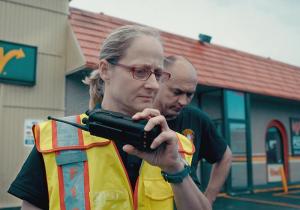How one fire chief is fighting “compassion fatigue” as overdoses mount

Jan Rader didn’t set out to become the face of first responders struggling with the toll of seeing one opioid overdose after another. But after her starring role in the Oscar-nominated documentary Heroin(e), and being named to Time Magazine’s 100 Most Influential People list, she’s sparking a national conversation about avoiding burnout.
In Huntington, W.Va., she said, first responders “started seeing 30, 40, 50 dead bodies a year, with no education or training on how to deal with the stress of that.” Now, Rader is testing and refining strategies for fighting “compassion fatigue” as part of the Bloomberg Philanthropies Mayors Challenge. Huntington is one of 35 Champion Cities prototyping new solutions to some of the most pressing urban challenges.
[Read: The Mayors Challenge: Unleashing the power of public prototyping]
In addition to embedding a mental health counselor with the department, Huntington is experimenting with offering personnel free yoga classes, mindfulness training, and massage therapy. The ideas came from first responders themselves. “We know that we probably can’t take away the stress,” Rader said, “so we’ve got to find ways to deal with it.”
This interview has been edited for length and clarity.
Bloomberg Cities: What’s the scope of the problem in Huntington?
Jan Rader: I’ve been a first responder for over 23 years, and I probably had 10 years on the job before I saw a significant amount of death. When I would see death it would typically be an elderly person who’d had a heart attack, or maybe somebody young dying tragically in a car wreck. But we didn’t see death from overdoses.
But then in 2014, ’15, ’16, ’17, it just kept increasing. As first responders, we started seeing 30, 40, 50 dead bodies a year, with no education or training on how to deal with the stress of that.
What toll is that taking on them?
We have a lot of first responders, people on the front lines of this epidemic, who are suffering. We see it with divorce, people leaving the job, sick time usage. There’s a frustration that goes along with overdoses, because it’s a very negative event — it’s negative for the person who overdoses, it’s negative for first responders, and it’s negative for friends and family who are there.
And it’s all day long, every day. Fifteen years ago, you might go on one overdose in a month. Now, at our peak, we were going on an average of 5.3 overdoses daily. That’s not all deaths, but the event itself of an overdose is so negative. First responders are reviving the same person over and over again until we eventually find them dead.
And it’s hard, because we’re supposed to be the cavalry: We fix the problem. So it’s frustrating, because we can’t fix this problem.
Has staff turnover become an issue?
In years past, people didn’t retire after 20 years of service as a firefighter — they’d stay 25 or 30 years. But now, as soon as they get their 20 years, they’re leaving to do other things because they’re so burned out. You have younger guys that come on and when they realize the magnitude of the job, they just go ahead and leave. So that’s a problem, and we certainly want to provide a more positive work environment for those on the front lines.
So what’s the strategy your testing out now?
We’re doing focus groups with first responders and trying to figure out what works best. As a chief, that’s really forcing me to grow, and it’s a good thing. Usually, the chief makes a decision and that’s final — I may have a theory on what may work with my guys. But here, we’re getting their opinions and testing out new ideas to see if they like it. And there’s been some surprises.
For instance, I did not think a majority of the guys would be interested in us having yoga classes for them. But through our focus groups, we found out that’s one of the biggest requests. So we’re getting ready to have yoga classes in fire stations and at the police department in the next couple of weeks.
Is there anything else you’re trying?
We’ve embedded a mental health counselor — she’s been embedded with the police department for over a year now, and now has been doing ride-alongs with the fire department as well. People trust her and they’re opening up to her. And that’s very refreshing. Because everybody needs a voice, and they need to be heard.
Hopefully we’ll be able to figure out the proper way to help people who believe we don’t need any help. There’s a stigma associated with even accepting any help. What we’ve found is they need to feel appreciated, and we’re listening to them, and we’re trying to provide programs for them that will make them feel appreciated. And give them an opportunity to build in a little self-care.
How else do you build in self-care?
We have mindfulness training going on. It’s an introductory 8-hour course for police and fire. And it’s a wonderful concept. It’s a way of being self-aware and being aware of your surroundings, which is very important as a first responder, to live in the moment and not in the past or future. Deal with what you’re dealing with right now. Stay keen to the dangers around you and the task at hand. I’m sure some will not accept it, but some will. And we’re testing to see if the majority find this helpful.
Is there anything you’re trying that you never would have imagined doing before?
In the next couple of weeks, we’re going to have massage therapists coming into the station, and going to the police department, and giving them massages while on duty. It’ll give them a half-hour break during their day, to see if that alleviates any stress. We know that we probably can’t take away the stress, so we’ve got to find ways to deal with it.
I’m also in the middle of writing a policy to test whether it would help to give firefighters an hour each day when they’re not expected to respond to an emergency unless it’s something major. Firefighters work 24 hours at a time — that’s extremely stressful. This would be an hour to do whatever they want to do, whether it’s exercise, or take a nice long walk, or catch a game on television — just giving them an hour to themselves in that 24-hour period to see if that would help.
What have you learned from this process that you’d like your peers in other cities to know?
We as leaders need to listen to our internal customers just as much as we listen to our external customers. We’re here to serve and protect, but we also need to make sure those who serve and protect are taken care of as well. Words matter, and kindness goes a long way.
Are you hopeful that things are going in the right direction in Huntington?
I think we’ve turned a corner here in Huntington. We’ve had an 8-month trend downward on our overdoses. It’s not fast enough for some people, but I’m a glass-is-half-full kind of gal, and I think we’re going to be OK on the other side of this. I think we’re moving in a positive direction, and I’m very hopeful for the future of the city of Huntington.


